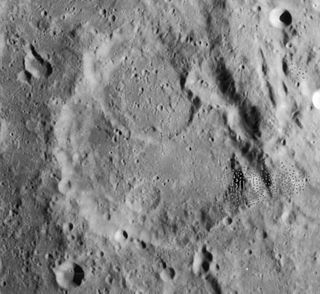
Catharina is an ancient lunar impact crater located in the southern highlands. It was named after Saint Catherine of Alexandria. It lies in a rugged stretch of land between the Rupes Altai scarp to the west and Mare Nectaris in the east. To the west-northwest is the crater Tacitus, and the lava-flooded Beaumont lies to the east along the shore of Mare Nectaris. To the south-southeast is Polybius.
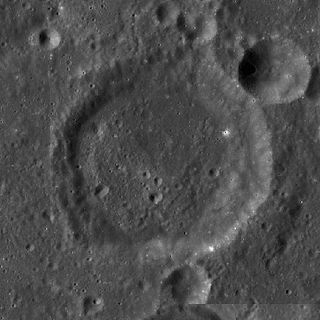
Almanon is a lunar impact crater that lies in the rugged highlands in the south-central region of the Moon. It was named after Abbasid Caliph and astronomer Al-Ma'mun. It is located to the south-southeast of Abulfeda, and to the north-northeast of the smaller crater Geber. The crater chain designated Catena Abulfeda forms a line between the south rim of Abulfeda and the north rim of Almanon, continuing for a length of about 210 kilometers to the Rupes Altai scarp.

Karrer is a lunar impact crater that is located in the southern hemisphere on the far side of the Moon. It lies to the northeast of the crater Minkowski, and south of Leavitt.

Chao Meng-Fu is a 167 km (104 mi) diameter crater on Mercury named after the Chinese painter and calligrapher Zhao Mengfu (1254–1322). Due to its location near Mercury's south pole and the planet's small axial tilt, an estimated 40% of the crater lies in permanent shadow. This combined with bright radar echoes from the location of the crater leads scientists to suspect that it may shelter large quantities of ice protected against sublimation into the near-vacuum by the constant −171 °C (−276 °F) temperatures.

The geology of Mercury is the scientific study of the surface, crust, and interior of the planet Mercury. It emphasizes the composition, structure, history, and physical processes that shape the planet. It is analogous to the field of terrestrial geology. In planetary science, the term geology is used in its broadest sense to mean the study of the solid parts of planets and moons. The term incorporates aspects of geophysics, geochemistry, mineralogy, geodesy, and cartography.

Yeats is an impact crater on the planet Mercury. The crater is named after William Butler Yeats, an Irish poet and dramatist. The name was adopted by the International Astronomical Union in 1976.

Rameau is a crater on Mercury. It was named by the IAU in 1976, after French composer Jean Philippe Rameau.
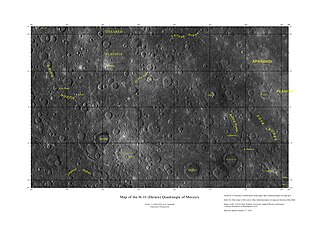
The Derain quadrangle (H-10) is one of fifteen quadrangles on Mercury. It runs from 288° to 360° west longitude and from 22° S to 22° N latitude. Named after the Derain crater, it was mapped in detail for the first time after MESSENGER entered orbit around Mercury in 2011. It had not been mapped prior to that point because it was one of the six quadrangles that was not illuminated when Mariner 10 made its flybys in 1974 and 1975. These six quadrangles continued to be known by their albedo feature names, with this one known as the Pieria quadrangle.
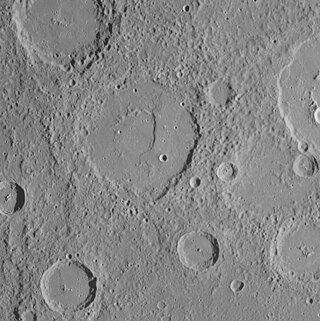
Boethius is a crater on the planet Mercury. It was named after Anicius Manlius Severinus Boethius, the Roman philosopher, by the IAU in 1976. The crater was first imaged by Mariner 10 in 1974.
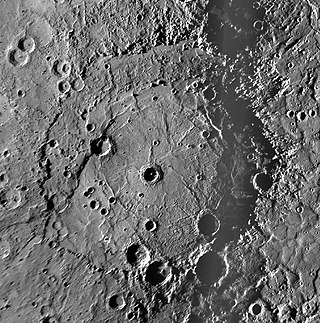
Rembrandt is a large impact crater on Mercury. With a diameter of 716 km it is the second-largest impact basin on the planet, after Caloris, and is one of the larger craters in the Solar System. It was discovered by MESSENGER during its second flyby of Mercury on October 6, 2008. The crater is 3.9 billion years old, and was created during the period of Late Heavy Bombardment. The density and size distribution of impact craters along Rembrandt's rim indicate that it is one of the youngest impact basins on Mercury.

Brontë is a crater on Mercury. It has a diameter of 68 kilometres. Its name was adopted by the International Astronomical Union in 1976. Bronte is named for English writers Charlotte Brontë, who lived from 1816 to 1855, Emily Brontë, who lived from 1818 to 1848, and Anne Brontë, who lived from 1820 to 1849, and English writer and artist Branwell Brontë, who lived from 1817 to 1848.

Chaikovskij is a crater on Mercury. It has a diameter of 171 kilometers. Its name was adopted by the International Astronomical Union (IAU) in 1976. Chaikovskij is named for the Russian composer Pyotr Ilyich Tchaikovsky, who lived from 1840 to 1893.

Darío is a crater on Mercury. It has a diameter of 151 kilometers. Its name was adopted by the International Astronomical Union (IAU) in 1976. Dario is named for the Nicaraguan poet Rubén Darío, who lived from 1867 to 1916.

Guido d'Arezzo is a crater on Mercury. It has a diameter of 58 kilometers. Its name was adopted by the International Astronomical Union (IAU) in 1976. Guido d'Arezzo is named for the Italian music theorist Guido of Arezzo, who lived from 990 to 1050.

Rupes Tenuis is a Martian north polar scarp. It is named after one of the classical albedo features on Mars. Its name was officially approved by IAU in 1988. It extends from latitude 74.94°N to 82.2°N and from longitude 242.12°E to 300.77°E. Its centre is located at latitude 81.6°N longitude 85.47°W. It marks the outer perimeter of Planum Boreum from longitude 242.12°E to 300.77°E, and it is formed by the eastern extension of the Olympia Cavi, a series of local troughs and depressions, which become longer and deeper as they merge to create the Rupes Tenuis scarp formation. The scarp is located to the west of Chasma Boreale, at the base of Planum Boreum, and its height varies from a few hundred metres to a maximum of approximately 1000 metres.

Enheduanna is a crater on Mercury. It has a diameter of 105 kilometers. Its name was suggested by Gagan Toor from India in a naming contest which was eventually adopted by the International Astronomical Union (IAU) on 2015. Enheduanna is named for the Sumerian poet Enheduanna. The craters Carolan, Kulthum, Karsh, and Rivera were also named as part of the contest.

Aneirin is a crater on Mercury. It has a diameter of 467 kilometers. Its name was adopted by the International Astronomical Union (IAU) on June 13, 2014. Aneirin is named for the Welsh poet Aneirin. Prior to naming, the crater was referred to as b37. It is Tolstojan in age.
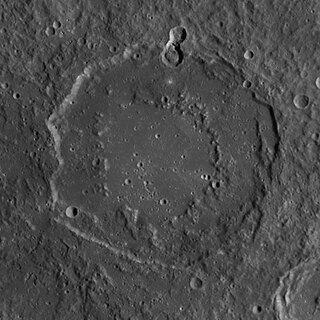
Nabokov is a crater on Mercury. Its name was adopted by the International Astronomical Union (IAU) on April 24, 2012. Nabokov is named for the Russian and American author Vladimir Nabokov.

Villa-Lobos is a crater on Mercury. Its name was adopted by the International Astronomical Union (IAU) on September 25, 2015. Villa-Lobos is named for the Brazilian composer Heitor Villa-Lobos.

Lovecraft is a crater on Mercury, located near the south pole. Its name was adopted by the International Astronomical Union (IAU) in 2013, after American author Howard Phillips Lovecraft.






















